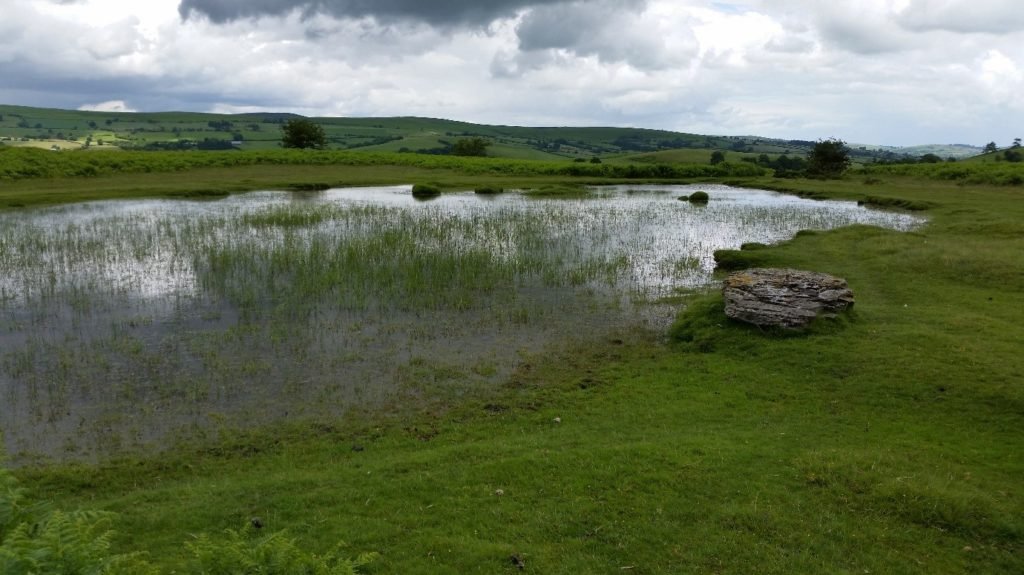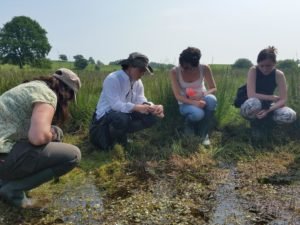Flagship Focus: The Begwns
19th September 2016
The Begwns Flagship Pond site, tucked away in a quiet corner of mid-Wales, is a very special freshwater site. People, Ponds & Water project officer Hannah is helping local people understand and take care of it.
 Looking north to the Radnorshire hills from the original National Pond Survey pond.
Looking north to the Radnorshire hills from the original National Pond Survey pond.
Freshwater Habitats Trust first got to know the Begwns ponds when we surveyed a large number of ponds in wild, untouched places across the UK for the National Pond Survey. These ponds then became a reference for what high quality, undamaged clean water ponds are like. Whilst the presence of Pillwort was known to local botanists, very little else was known about how special this site is for freshwater wildlife.
 The tiny aquatic fern Pillwort grows in abundance on the Begwns. Its name is derived from the round structure, or pill, at the base of the plant. Photo by Anne Heathcote.
The tiny aquatic fern Pillwort grows in abundance on the Begwns. Its name is derived from the round structure, or pill, at the base of the plant. Photo by Anne Heathcote.
Over the years, more records have been collected, and we now know that the ponds on the Begwns Common are also home to several uncommon pond plants including Tubular Water-dropwort, Mudwort, Floating Club-rush, Unbranched Burreed, and the stonewort Nitella opaca. In fact, the largest of the 18 ponds on the Begwns is the best site for Tubular Water-dropwort in Radnorshire.
Whilst looking at some of the ponds on the common last September, Hannah discovered the presence of the reed beetle Donacia versicolorea and earlier this year, beetle specialist John Bratton surveyed the ponds and discovered two more special species: the Reed Beetle D. vulgaris and a small crawling water beetle Helophorus griseus. These beetles are significant because they require clean water and high quality habitats free from agricultural intensification.
The amphibian survey in April this year found that all five of Wales’ widespread amphibians are present in the ponds on the Begwns: the three newt species, common frog and common toad.
 A PondNet training event at the Begwns earlier this year.
A PondNet training event at the Begwns earlier this year.
The Flagship Pond project, supported by the Heritage Lottery Fund, is helping the Begwns Pond Group, local people who care about the wildlife of the site, to gather more information on the plants and animals that live there. The Group was set up by site owner, the National Trust, to monitor the Pillwort in the ponds to update the previous Pillwort survey undertaken in 1994 by the National Trust. The Flagship Pond project is expanding the Pillwort survey to other pond species and is providing training for the staff and volunteers in surveying and monitoring the plants, invertebrates and amphibians, and helping them co-ordinate regular walk-bys to keep an eye out for the invasive non-native plant Crassula helmsii. Unfortunately Crassula has invaded ponds on nearby commons and as a result rare native pond species such as Pillwort and Mudwort have been lost. Early warning of the presence of this plant makes it much more likely that it can be successfully removed. Left unchecked it can have a dramatic effect on pond wildlife, often causing the loss of these rare wet mud specialists by smothering the bare mud habitat.
The information collected by the volunteers helps the site managers better understand the site’s wildlife, and allows well-informed decisions to be made on the future management of the common.
Want to know more?
- Read more about the Flagship Ponds project
- Learn about other parts of our People, Ponds & Water project, and how you can get involved
- Find out how your support can make a difference for freshwater wildlife
- Join the mailing list to get articles like this, and more, direct to your inbox
